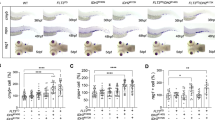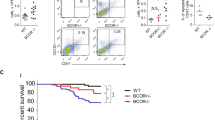Abstract
The RUNX1/AML1 gene on chromosome 21 is most frequently inactivated in human leukemias. In addition, an increased dose of RUNX1 is suggested as a basis for several kinds of leukemias. Amplifications of chromosome 21 or the RUNX1 gene are shown to be associated with leukemias with lymphoid lineage, whereas its involvement in myeloid lineage remains unclear. In this study, we generated GATA-1 promoter-driven Runx1 transgenic (Tg) mice, which showed a transient mild increase of megakaryocyte marker-positive myeloid cells but no spontaneous leukemia. These mice were then crossed with BXH2 mice, which have a replication-competent retrovirus in the mouse and develop myeloid leukemia due to insertional mutagenesis by random integration of the virus. Overexpressed Runx1 transgene in BXH2 mice resulted in shortening of the latency of leukemia with increased frequency of megakaryoblastic leukemia, suggesting that increased Runx1 dosage is leukemogenic in myeloid lineage. Identifications of retroviral integration sites revealed the genetic alterations that may cooperate with Runx1 overdose in myeloid leukemogenesis. This mouse model may be useful for analysing the pathogenesis of myeloid leukemias with RUNX1 overdose, especially to examine whether an extra-copy of RUNX1 by trisomy 21 is causally related to Down's syndrome-related acute megakaryoblastic leukemia (DS-AMKL).
This is a preview of subscription content, access via your institution
Access options
Subscribe to this journal
Receive 50 print issues and online access
$259.00 per year
only $5.18 per issue
Buy this article
- Purchase on Springer Link
- Instant access to full article PDF
Prices may be subject to local taxes which are calculated during checkout





Similar content being viewed by others
References
Akagi K, Suzuki T, Stephens RM, Jenkins NA and Copeland NG . (2004). Nucleic Acids Res., 32 (Database issue), D523–D527.
Antonarakis SE . (1998). Genomics, 51, 1–16.
Bernardin-Fried F, Kummalue T, Leijen S, Collector MI, Ravid K and Friedman AD . (2004). J. Biol. Chem., 279, 15678–15687.
Bromberg JF, Wrzeszczynska MH, Devgan G, Zhao Y, Pestell RG, Albanese C and Darnell Jr JE . (1999). Cell, 98, 295–303.
Brooks AR, Shiffman D, Chan CS, Brooks EE and Milner PG . (1996). J. Biol. Chem., 271, 9090–9099.
Dufresne-Zacharia MC, Dahmane N, Theophile D, Orti R, Chettouh Z, Sinet PM and Delabar JM . (1994). Genomics, 19, 462–469.
Elagib KE, Racke FK, Mogass M, Khetawat R, Delehanty LL and Goldfarb AN . (2003). Blood, 101, 4333–4341.
Fagerlund R, Melen K, Kinnunen L and Julkunen I . (2002). J. Biol. Chem., 277, 30072–30078.
Gjertson C, Sturm KS and Berger CN . (1999). Clin. Immunol., 91, 50–60.
Gurbuxani S, Vyas P and Crispino JD . (2004). Blood, 103, 399–406.
Hock H, Hamblen MJ, Rooke HM, Traver D, Bronson RT, Cameron S and Orkin SH . (2003). Immunity, 18, 109–120.
Kirito K, Osawa M, Morita H, Shimizu R, Yamamoto M, Oda A, Fujita H, Tanaka M, Nakajima K, Miura Y, Ozawa K and Komatsu N . (2002). Blood, 99, 3220–3227.
Kobayashi M, Nishikawa K and Yamamoto M . (2001). Development, 128, 2341–2350.
Li J, Shen H, Himmel KL, Dupuy AJ, Largaespada DA, Nakamura T, Shaughnessy Jr JD, Jenkins NA and Copeland NG . (1999). Nat. Genet., 23, 348–353.
Liu W, Toyosawa S, Furuichi T, Kanatani N, Yoshida C, Liu Y, Himeno M, Narai S, Yamaguchi A and Komori T . (2001). J. Cell. Biol., 155, 157–166.
Look AT . (1997). Science, 278, 1059–1064.
McElwaine S, Mulligan C, Groet J, Spinelli M, Rinaldi A, Denyer G, Mensah A, Cavani S, Baldo C, Dagna-Bricarelli F, Hann I, Basso G, Cotter FE and Nizetic D . (2004). Br. J. Haematol., 125, 729–742.
Michaud J, Wu F, Osato M, Cottles GM, Yanagida M, Asou N, Shigesada K, Ito Y, Benson KF, Raskind WH, Rossier C, Antonarakis SE, Israels S, McNicol A, Weiss H, Horwitz M and Scott HS . (2002). Blood, 99, 1364–1372.
Niini T, Kanerva J, Vettenranta K, Saarinen-Pihkala UM and Knuutila S . (2000). Haematologica, 85, 362–366.
Ning ZQ, Li J and Arceci RJ . (2001). Blood, 97, 3559–3567.
Onodera K, Takahashi S, Nishimura S, Ohta J, Motohashi H, Yomogida K, Hayashi N, Engel JD and Yamamoto M . (1997). Proc. Natl. Acad. Sci. USA, 94, 4487–4492.
Osato M, Asou N, Abdalla E, Hoshino K, Yamasaki H, Okubo T, Suzushima H, Takatsuki K, Kanno T, Shigesada K and Ito Y . (1999). Blood, 93, 1817–1824.
Reeves RH, Baxter LL and Richtsmeier JT . (2001). Trends Genet., 17, 83–88.
Rodel B, Tavassoli K, Karsunky H, Schmidt T, Bachmann M, Schaper F, Heinrich P, Shuai K, Elsasser HP and Moroy T . (2000). EMBO J., 19, 5845–5855.
Saleque S, Cameron S and Orkin SH . (2002). Genes Dev., 16, 301–306.
Shivdasani RA, Fujiwara Y, McDevitt MA and Orkin SH . (1997). EMBO J., 16, 3965–3973.
Song WJ, Sullivan MG, Legare RD, Hutchings S, Tan X, Kufrin D, Ratajczak J, Resende IC, Haworth C, Hock R, Loh M, Felix C, Roy DC, Busque L, Kurnit D, Willman C, Gewirtz AM, Speck NA, Bushweller JH, Li FP, Gardiner K, Poncz M, Maris JM and Gilliland DG . (1999). Nat. Genet., 23, 166–175.
Speck NA and Gilliland DG . (2002). Nat. Rev. Cancer, 2, 502–513.
Strom DK, Nip J, Westendorf JJ, Linggi B, Lutterbach B, Downing JR, Lenny N and Hiebert SW . (2000). J. Biol. Chem., 275, 3438–3445.
Sui X, Tsuji K, Ebihara Y, Tanaka R, Muraoka K, Yoshida M, Yamada K, Yasukawa K, Taga T, Kishimoto T and Nakahata T . (1999). Blood, 93, 2525–2532.
Tassone F, Lucas R, Slavov D, Kavsan V, Crnic L and Gardiner K . (1999). J. Neural. Transm., 57 (Suppl), 179–195.
Vaillant F, Blyth K, Terry A, Bell M, Cameron ER, Neil J and Stewart M . (1999). Oncogene, 18, 7124–7134.
Wechsler J, Greene M, McDevitt MA, Anastasi J, Karp JE, Le Beau MM and Crispino JD . (2002). Nat. Genet., 32, 148–152.
Wotton S, Stewart M, Blyth K, Vaillant F, Kilbey A, Neil JC and Cameron ER . (2002). Cancer Res., 62, 7181–7185.
Zhang Y, Nagata Y, Yu G, Nguyen HG, Jones MR, Toselli P, Jackson CW, Tatsuka M, Todokoro K and Ravid K . (2004). Blood, 103, 3717–3726.
Zimmet J and Ravid K . (2000). Exp. Hematol., 28, 3–16.
Zimmet JM, Ladd D, Jackson CW, Stenberg PE and Ravid K . (1997). Mol. Cell. Biol., 17, 7248–7259.
Acknowledgements
We thank Scott Kogan for his gift of the BXH2 mice and Gwee QiRu, Tan Mia Yan, Melissa Y Lin, and Gregory M Cottles for their technical assistance. This study was supported by A*STAR (Agency for Science, Technology and Research), Singapore.
Author information
Authors and Affiliations
Corresponding author
Rights and permissions
About this article
Cite this article
Yanagida, M., Osato, M., Yamashita, N. et al. Increased dosage of Runx1/AML1 acts as a positive modulator of myeloid leukemogenesis in BXH2 mice. Oncogene 24, 4477–4485 (2005). https://doi.org/10.1038/sj.onc.1208675
Received:
Revised:
Accepted:
Published:
Issue Date:
DOI: https://doi.org/10.1038/sj.onc.1208675
Keywords
This article is cited by
-
Childhood hematopoietic stem cells constitute the permissive window for RUNX1-ETO leukemogenesis
International Journal of Hematology (2023)
-
RUNX1 haploinsufficiency results in granulocyte colony-stimulating factor hypersensitivity
Blood Cancer Journal (2016)
-
Trisomic dose of several chromosome 21 genes perturbs haematopoietic stem and progenitor cell differentiation in Down's syndrome
Oncogene (2010)
-
Trisomy 21 leukemias: finding the hits that matter
Oncogene (2010)
-
Erythroid and megakaryocytic transformation
Oncogene (2007)



